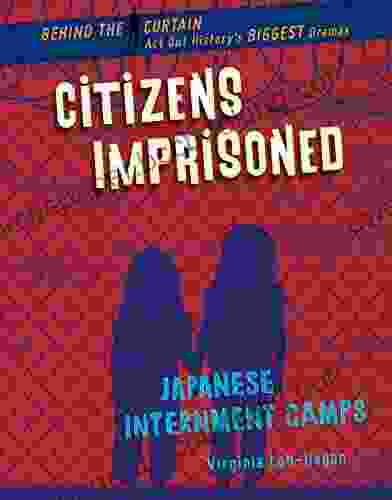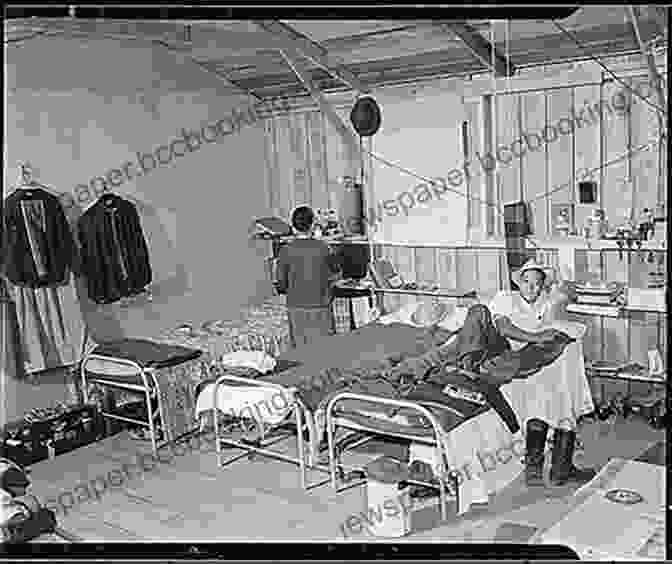Unveiling the Hidden Truths: "Citizens Imprisoned: Japanese Internment Camps Behind the Curtain"

During the tumultuous years of World War II, a dark chapter unfolded in American history when thousands of Japanese immigrants and their American-born children were forcibly removed from their homes and incarcerated in internment camps. The book "Citizens Imprisoned: Japanese Internment Camps Behind the Curtain" meticulously documents this shameful episode, shedding light on the harrowing experiences of those who endured this grave injustice.
Prelude to Incarceration
The roots of the internment camps can be traced back to decades-old prejudices against Japanese immigrants. Anti-Japanese sentiment had been simmering in the United States since the turn of the century, fueled by economic competition, cultural differences, and the lingering wounds of the Russo-Japanese War.
4.7 out of 5
| Language | : | English |
| File size | : | 32246 KB |
| Print length | : | 32 pages |
With the outbreak of World War II and the attack on Pearl Harbor, these prejudices reached fever pitch. The Roosevelt administration, fearing that Japanese immigrants might pose a security risk, authorized the War Department to round up and detain all persons of Japanese ancestry living on the West Coast.
The Internment Process
Executive Free Download 9066, signed by President Roosevelt on February 19, 1942, gave the military broad authority to remove Japanese Americans from their homes. Within weeks, over 120,000 people were forcibly evacuated to hastily constructed internment camps located in remote areas of the country.
The camps were overcrowded, unsanitary, and lacked basic amenities. Families were crammed into barracks-like housing units, deprived of privacy and dignity. Camp life was a constant struggle for survival, with inmates facing shortages of food, clothing, and medical care.
Life Behind the Curtain
The internment camps were a world unto themselves, separated from the outside world by a literal curtain of secrecy. The government imposed strict censorship, suppressing any news or reports that could potentially damage the war effort.
Within the camps, a complex social hierarchy developed. Some inmates held positions of authority as community leaders or camp administrators, while others faced discrimination and hardship. The camp environment fostered a sense of both resilience and despair among its inhabitants.
Resistance and Resilience
Despite the overwhelming hardships they faced, many Japanese Americans refused to succumb to despair. They formed resistance groups, organized protests, and pursued education and creative activities within the confines of the camps.
Through letters, journals, and artworks, the inmates documented their experiences and preserved their cultural heritage. Their determination to maintain their dignity in the face of adversity became a powerful testament to the human spirit.
The Aftermath
The Japanese internment camps were finally closed in March 1946, after the end of the war. The inmates were released, but they faced a hostile society that was reluctant to welcome them back. Many lost their homes, businesses, and livelihoods.
In the years that followed, efforts were made to redress the injustices of the internment. In 1988, President Ronald Reagan signed the Civil Liberties Act, providing reparations to surviving camp inmates. However, the scars of the experience continue to linger in the Japanese American community.
Legacy and Lessons Learned
The Japanese internment camps remain a shameful reminder of the fragility of civil liberties in times of crisis. The book "Citizens Imprisoned" serves as a vital historical record, ensuring that this dark chapter is never forgotten.
By studying the experiences of those who endured the camps, we can learn valuable lessons about the dangers of prejudice, the importance of due process, and the resilience of the human spirit. The book challenges us to confront the uncomfortable truths of our past and to work towards a more just and equitable future.
4.7 out of 5
| Language | : | English |
| File size | : | 32246 KB |
| Print length | : | 32 pages |
Do you want to contribute by writing guest posts on this blog?
Please contact us and send us a resume of previous articles that you have written.
 Book
Book Novel
Novel Page
Page Chapter
Chapter Text
Text Story
Story Genre
Genre Reader
Reader Library
Library Paperback
Paperback E-book
E-book Magazine
Magazine Newspaper
Newspaper Paragraph
Paragraph Sentence
Sentence Bookmark
Bookmark Shelf
Shelf Glossary
Glossary Bibliography
Bibliography Foreword
Foreword Preface
Preface Synopsis
Synopsis Annotation
Annotation Footnote
Footnote Manuscript
Manuscript Scroll
Scroll Codex
Codex Tome
Tome Bestseller
Bestseller Classics
Classics Library card
Library card Narrative
Narrative Biography
Biography Autobiography
Autobiography Memoir
Memoir Reference
Reference Encyclopedia
Encyclopedia Karen Weekly
Karen Weekly Justin Monroe
Justin Monroe Mitsuo Kure
Mitsuo Kure Julyen Rose
Julyen Rose Nina Disesa
Nina Disesa Julia Ann Clayton
Julia Ann Clayton Nicole Eustace
Nicole Eustace Naomi Moriyama
Naomi Moriyama Lisa Kenney
Lisa Kenney Rod Dreher
Rod Dreher Susan Wittig Albert
Susan Wittig Albert Lisa R Cohen
Lisa R Cohen Julia Albright
Julia Albright Karen Rands
Karen Rands Kara Cooney
Kara Cooney Justin Michael
Justin Michael Todd Costa Rica
Todd Costa Rica Karen A Moon
Karen A Moon Katharine A Phillips
Katharine A Phillips Meggie Clear
Meggie Clear
Light bulbAdvertise smarter! Our strategic ad space ensures maximum exposure. Reserve your spot today!

 Dean ButlerThe Promised Neverland Vol 12: Starting Sound - A Heart-Pounding Chapter in...
Dean ButlerThe Promised Neverland Vol 12: Starting Sound - A Heart-Pounding Chapter in...
 Braeden HayesUnveiling the American Presidents Series: A Historical Tapestry of Leadership...
Braeden HayesUnveiling the American Presidents Series: A Historical Tapestry of Leadership... Isaiah PriceFollow ·16.7k
Isaiah PriceFollow ·16.7k Andy ColeFollow ·19.4k
Andy ColeFollow ·19.4k John GrishamFollow ·18.2k
John GrishamFollow ·18.2k Thomas MannFollow ·14k
Thomas MannFollow ·14k Curtis StewartFollow ·2k
Curtis StewartFollow ·2k Brent FosterFollow ·17.3k
Brent FosterFollow ·17.3k Forrest ReedFollow ·9.9k
Forrest ReedFollow ·9.9k Miguel de CervantesFollow ·19k
Miguel de CervantesFollow ·19k

 Drew Bell
Drew BellLife and Death in West Africa: A Groundbreaking Account...
A Journey Through...

 Stanley Bell
Stanley BellMaster the Art of Fly Fishing Line Management: A...
Are you an avid fly...

 Ernest Powell
Ernest PowellUnleash Your Entrepreneurial Spirit: A Comprehensive...
In the competitive...

 Derrick Hughes
Derrick HughesMaster Your Ride: The Ultimate Guide to Road Bike...
Are you ready to elevate your cycling...

 Camden Mitchell
Camden MitchellUnveiling the Enchanting World of American Royals III:...
Embark on a Captivating Royal Saga: American...

 Richard Simmons
Richard SimmonsUnveiling the Secrets of Fly Tying: A Comprehensive...
In the realm of...
4.7 out of 5
| Language | : | English |
| File size | : | 32246 KB |
| Print length | : | 32 pages |









